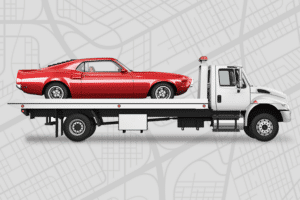Shipping classic cars and antiques isn’t just about moving stuff; it’s like transporting pieces of history and heart. Imagine sending off a vintage car that’s all about the ’60s vibes, or an antique chair that seems to whisper stories from long ago. These aren’t just things; they’re memories and dreams on wheels or in boxes, needing a whole lot of TLC to get from here to there.
Getting these precious pieces safely to their new home is a bit like a special mission. It’s not just about picking a service; it’s about finding the right kind of care—maybe an enclosed space for your classic ride or a climate-friendly option for those fragile antiques.
Don’t let this scare you. Whether you’re sending off a piece to a new owner, moving to a dream location, or just keeping those family stories alive and well, we’ve got your back. We’ll walk you through how to ship your vehicle and antiques safely, covering all the bases from A to Z. Ready to get moving without the headaches? Keep reading to learn all about making sure your prized pieces travel safely and arrive in style.
FACTORS TO CONSIDER BEFORE SHIPPING CLASSIC CARS
Before you hand over your cherished classic car or antique to a carrier, there are several crucial factors to consider. These preparatory measures will help safeguard your investment and ensure a smooth transition.
STEP 1: PREPARE FOR THE ADVENTURE
- Record its Current State: Before shipping, take several photos and compile detailed descriptions of your classic car’s condition.
- Repair Any Damages: To minimize potential harm during transit, address any damage or wear beforehand.
- Secure Loose Parts: Attach detachable sections firmly or carefully pack them separately for added safety.
- Lower Fluid Levels: In vehicles, reduce fuel tank levels to less than a quarter, preventing potential spills and reducing overall weight.
STEP 2: FINANCIALLY PROTECT YOUR INVESTMENT
- Determine Appropriate Insurance: Based on your item’s unique qualities and worth, determine the type and extent of coverage or additional protection required.
STEP 3: NAVIGATE THE LEGAL LANDSCAPE
- Gather the necessary permits and certificates: Contact the appropriate authorities to determine which documents you’ll need to lawfully move your classic car or antique.
- Understand Import/Export Regulations: Educate yourself on customs procedures, taxes, and any applicable fees associated with moving your item internationally.
By taking these steps, you’ll effectively shield your cherished classic car or antique from potential risks during shipping. Preserving its value and historical importance remains paramount, enabling you to enjoy the thrilling experience of having it transported to its new home.
Remember, patience and due diligence pay off when dealing with the logistics of shipping a classic car or antique. With this comprehensive guide, you’ll have the knowledge and tools necessary to make informed decisions and ensure a positive outcome for your beloved possession.
CHOOSING THE RIGHT METHOD FOR SHIPPING CLASSIC CARS

Navigating the waters of shipping your classic car or beloved antique can feel like plotting a course through uncharted territory. Fear not! We’re here to illuminate the path with straightforward and actionable advice, ensuring your prized possessions reach their destination safely and without a hitch.
Open Air vs. Enclosed Carrier: Making the Choice
- Enclosed Transport: Envision your item, be it a gleaming classic car or a delicate antique, safely nestled within the confines of a sturdy, weatherproof trailer. Every speck of dust and drop of rain shields it. This method is your best bet for long journeys or when Mother Nature can’t make up her mind.
- Open Transport: Are you on a tight budget but still need reliable transportation? Open transport has got you covered. Your item will ride in the open air, basking in the scenery alongside other cars. It’s a solid choice for shorter distances and sturdier items that can handle a bit of exposure.
Specialty Carriers: The Experts in Care
Turning to specialty carriers for that extra layer of security and expertise is like hiring a personal bodyguard for your item. These professionals bring not only specialized equipment and vehicles but also a deep understanding of what your classic car or antique requires to travel safely.
Tracking Down the Perfect Carrier
Finding a carrier you can trust involves a little legwork. Dive into online reviews, seek out recommendations from fellow enthusiasts or professionals, and don’t hesitate to reach out to industry associations. Comparing quotes and services will help you find the best fit for your unique needs.
Takeaway
Choosing the ideal shipping method for your classic car or antique isn’t just a logistical decision; it’s about peace of mind. Whether it’s wrapping your item in the protective embrace of enclosed transport, opting for the efficiency of air freight, or enlisting the expertise of specialty carriers, understanding your options is key. With a little research and insight into the nuances of each choice, you’re well on your way to a seamless and secure shipping experience, ensuring your treasured items arrive just as they should—perfect and punctual.
SPECIALIZED PACKAGING AND HANDLING TECHNIQUES
Shipping classic cars is a unique process that demands special attention, thanks to their distinctive characteristics and significant value. Professionals handle these precious vehicles with utmost care at every step of their journey.
Choosing the Right Containers
Classic cars require strong, reliable containers to protect them from bumps, bangs, and the ups and downs of air pressure during transit. The go-to solutions? Tough cardboard boxes are reinforced for extra strength, and sturdy plastic containers are designed to take a beating.
Mastering Protective Packing
The packaging is the key to safe shipping. Wrap every fragile part of the car with protective materials such as bubble wrap, soft tissue paper, or foam peanuts. These buffers absorb shocks and keep everything stable and secure. Sometimes, it’s even necessary to craft custom boxes that snugly fit the unique shapes of antique automotive parts, ensuring they don’t budge an inch on the road.
Navigating Regulations with Ease
Crossing borders with an antique car means dealing with a maze of regulations and paperwork. Having a deep understanding of international shipping laws and all the necessary documents in hand, and securing any necessary permits or licenses ensures the smoothest trips. It’s about making sure your classic car not only travels safely but is also fully compliant with the laws of the land it crosses.
Shipping a classic car isn’t just about moving an object from point A to point B. It’s about preserving a piece of history, making sure it arrives not just safely but in the same condition it left. With these specialized techniques, professionals make sure every journey is as smooth as the ride in one of these timeless beauties.
REGULATORY COMPLIANCE AND DOCUMENTATION
Getting your classic car across borders isn’t just about booking a shipment; it’s about diving deep into a world of regulations and paperwork that can feel as complex as restoring the car itself. Let’s simplify the steps you need to take to ensure your vintage beauty complies with international laws and reaches its new home without a hitch.
Understanding International Shipping Regulations
First things first, you need to get a handle on the specific laws that apply to shipping antique vehicles internationally. Here’s what to look out for:
Age Matters: Your car’s vintage status could qualify it for certain benefits, like duty waivers or tax reductions. Make sure you know the age requirements.
Duties and Taxes: The cost of moving your classic car might vary greatly depending on its value, age, and the country you’re shipping to. Do the math early.
Check for Restrictions: Some countries might not be fans of modifications or certain types of vehicles. Knowing this in advance saves headaches.
Gathering Your Paperwork
Paperwork is your friend, as it proves the legitimacy of your vehicle and the terms of its journey. You’ll need:
- Bill of Sale/Commercial Invoice: This shows the purchase details, including who’s involved and the price.
- Customs Declaration: It’s crucial to declare your vehicle correctly, listing out all the necessary details like make, model, and serial numbers.
- Extra Documentation: Depending on your destination, you may need additional paperwork such as Certificates of Origin or Title documents.
Obtaining Permits and Licenses
Certain permits and licenses are non-negotiable for international shipping:
- Temporary Import Permits: These allow your vehicle to temporarily enter another country without full duties.
- Export Permits: These are required for legally sending your vehicle out of the country.
- Historical Significance Certification: This can help if your vehicle is of historical importance, possibly offering more favorable tax treatment.
For guidance, reaching out to consular offices or industry experts can be incredibly helpful. They can offer insights and advice tailored to your specific situation, ensuring that you’re prepared for every step of the journey.
Armed with the right information and documentation, you’ll be ready to take on the world, or at least send your precious piece of automotive history across it.
SELECTING A RELIABLE SHIPPING PROVIDER
Shipping a classic car isn’t just about moving an item; it’s about caring for a piece of automotive history. If you’re new to this, the process might seem a bit daunting. Don’t worry, we’ll walk you through how to find a carrier that understands the value of your prized possession and ensures its safe delivery.
Start With Research
The first step is to look into transport companies that have a solid background in transporting classic cars. It’s essential to choose a provider with the right expertise because they’ll know exactly how to handle your car with the care it deserves. Check out their services and see if they specialize in vintage automobiles. This could make all the difference in ensuring your car’s safety.
Dive into Reviews
In this digital age, you can learn a lot from what others have to say. Spend some time reading reviews and testimonials from customers who’ve shipped classic cars before. It’s not just the glowing reviews you should be interested in; see how the company responds to any negative feedback. This will give you a good sense of its commitment to customer service and how it handles any bumps in the road.
Understanding Quotes
Getting quotes from different companies is about more than just comparing prices. It’s your opportunity to see who lays out their plan most clearly for you. A good carrier will provide a detailed quote that explains exactly how it’ll take care of your car, from the moment it picks the car up to when it delivers it. Look for transparency and honesty in its pricing, and be wary of any hidden fees.
Takeaway
Finding the perfect shipping service for your classic car involves trusting it with more than just a vehicle; you’re handing over a piece of history. By doing your research, reading up on past customer experiences, and carefully comparing quotes, you’ll be well on your way to finding a shipping partner who treats your classic car with the respect and care it deserves. Imagine this process as finding a new home for your car, where it will receive the same love and care you provide.
TRACKING AND MONITORING SHIPMENTS
Ensuring the smooth transit of your classic automobile hinges on two critical actions: actively monitoring its journey through tracking technology and keeping an open line of communication with your transportation provider.
Maintaining Dialogue with Your Transporter
Consistent interaction with your transporter is key to a seamless shipment process. This connection ensures you’re continuously in the loop, able to obtain updates or pose inquiries as needed. The ease with which you can contact your transporter eliminates any uncertainty about your vehicle’s status or delivery timeline. It’s vital that your transporter is approachable and responsive, ready to demystify the process or tackle any queries you might have.
Addressing Setbacks and Obstacles with Foresight
The path to delivering your vehicle isn’t always devoid of hurdles or hold-ups. Handling these unforeseen events can significantly impact the outcome. By staying vigilant through tracking and keeping the lines of communication open with your transporter, you can swiftly pinpoint and confront any arising issues. Taking immediate measures to communicate and collaborate with your transporter facilitates quick resolutions, diminishes worries, and ensures your classic car stays on its intended course. By embracing these proactive measures and fostering informed oversight, you champion a hassle-free and effective shipping experience, guaranteeing the safe and timely arrival of your prized automobile.
TIPS FOR ENSURING SAFE DELIVERY INSPECTION UPON ARRIVAL
When your item arrives, it’s crucial to check it carefully for any damage. If you find any issues, take clear photos as proof. Immediately report these damages to the carrier and follow its process for making a claim. After the experience, share your feedback with the carrier, whether good or bad, to help improve its service.
Your car’s arrival is a critical moment. Set aside time to thoroughly inspect your car for any damage that may have occurred during transit. Identifying and reporting any issues immediately is vital for starting the claims process efficiently. Once resolved, sharing your feedback, whether it’s positive reinforcement or constructive advice, can help improve services for everyone.
In simpler terms, once your item arrives, give it a good once-over to ensure it’s in top shape. If you spot any issues, document them well and reach out to the carrier to get the situation fixed. Afterward, sharing how it all went can help improve the service for everyone down the line.
CASE STUDIES AND CUSTOMER REVIEWS
Let’s dive into some real customer reviews from uShip, where precious classic cars made their way safely to new homes. These tales aren’t just about moving things from A to B; they’re about the care, expertise, and trust uShip brings to each journey.
“The process of setting up car transport was very simple. The company I chose was very fast to respond and got my vehicle to me in a shorter time than expected. I was very impressed.”—Rich I.
“My experience with uShip was flawless. The price was better than what had been offered by any other carrier, the service was door-to-door, and they handled it perfectly with an excellent truck and 26-foot enclosed trailer. I am a seller in Vancouver. The purchaser of the car in Tisdale, Saskatchewan was very pleased.” – Alyn E.
“I got very quick responses from carriers, and I was able to book a company as soon as I knew I needed the car picked up. The car was picked up in about 24 hrs by two wonderful drivers who got the car to my home a little over 48 hrs later. They were very careful and communicated with me the whole way. Would hire that same company again in a heartbeat.” – Kerry S.
Read more customer reviews on TrustPilot.

CONCLUSION
Shipping your classic or antique car can be straightforward and stress-free with the right approach. Utilizing tools like real-time tracking, staying in contact with your carrier, and conducting a thorough inspection upon arrival puts you in charge of the shipping process. Your car’s journey should be as enjoyable as driving it. Ready to be a success story? Explore your shipping options and join the ranks of happy customers who have navigated their cars to their new destinations efficiently and safely. Your classic car’s next adventure waits, promising a seamless experience.
MOST COMMON QUESTIONS PEOPLE ALSO ASK (PAA)
How much does it cost to ship a classic car?
The cost to ship a classic car can range from a few hundred to a few thousand dollars. Factors like distance, vehicle size, shipping method (open vs. enclosed trailer), and any added services will impact the total cost.
What is the safest way to transport antiques?
The safest way is to use an experienced antique car carrier that specializes in handling classic vehicles.
How do I prepare my classic car for shipping?
Do a thorough inspection and document any pre-existing damages. Disable the alarm, ensure low battery levels, and apply a protective covering. Disable the parking brake and fill the gas tank no more than one-quarter full.
Are there restrictions on shipping classic cars internationally?
Yes, there are often restrictions around imports/exports, required paperwork like titles and customs forms, and procedures for qualifying cars as antiques. Research regulations for both origin and destination countries.
Can I track the progress of my antique shipment?
Nowadays, most carriers offer tracking services that allow you to view the shipment’s location and progress. Some may also provide project-specific updates along the way.
What should I do if my classic car arrives damaged?
Document all damages immediately with photographs, request an inspection report, and file a claim right away with the carrier’s insurance company or open a case with uShip. For severe damages, do not attempt repairs until instructed.
Do I need to be present for pickup/delivery?
It’s highly recommended that owners make arrangements to be present both when the items are picked up and delivered. This allows you to do a final inspection and point out any specific handling needs.
Are there specific carriers for transporting antiques?
While many carriers will ship antique vehicles, there are companies that specialize exclusively in moving high-value, delicate, and irreplaceable items like classic cars.
How far in advance should I book a shipment?
For seamless logistics, most carriers recommend booking at least 2-4 weeks in advance. More notice may be needed around holidays or if specific equipment or transit modes are required.



